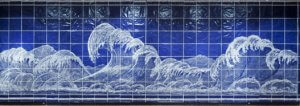
Douglas Walker: Other Worlds


Douglas Walker’s mostly monochromatic blue paintings on paper from the past decade are executed in a manner that pays homage both to historical fine art illustration and the graphic production strategies found in “outsider art” and tattoo culture. For the past few years, Walker’s imagery has revolved around three motifs: fantastical, other-worldly landscapes with mutant, modernist architectural structures; portraits of mid-20th century women in which, for example, garments and hair morph into plant-like image-fields; and sinewy floral tendrils that evoke Victorian-era graphic flourishes. All of the works are created using a resist technique of Walker’s invention where the image emerges from multiple, simultaneous applications of water and oil- based materials that often yield unexpected textural results. The surfaces simulate crackled 18th century Delft-blue ceramic glazing—which itself quotes the Chinese porcelain that was highly valued by the colonial Dutch traders. These paintings are Walker’s visitations to other places—perhaps real, perhaps imagined—where exotic graphic figures, human and otherwise, float in science fiction-like fields and atmospheres.
Walker has created new architecturally-scaled paintings for Other Worlds that synthesize pictorial components of his previous imagery into single works, including a full-scale representation of a sperm whale flanked by a moon-like celestial body and an androgynous mask-like face. The crackled patterns in the interior “spaces” of many of these depictions call to mind cellular structures and micro-organic matter; rendered together they form transparent, x-ray-like atmospheres. By playing with these complex figure-ground relationships, Walker interweaves multiple layers and points of view—from the telescopic to microscopic—within his work.
These paintings also explore the larger notion of the relationship and tensions between the physical and the elemental. A whale—a global migrator and the largest mammal on the planet—shares gallery space with the moon and its celestial orbit that regulates oceanic tides and other planetary rhythms.
Remaining unfixed in specific meaning, Walker’s images appear to be rooted assuredly in an experience of an earth that we collectively know. Yet there are too many little slippages, distortions and embellishments within the images to make us feel certain whether what we are looking at is from this world—or another.

Organized by Dalhousie Art Gallery in partnership with The Robert McLaughlin Gallery and the Kelowna Art Gallery
Curated by Peter Dykhuis and Corinna Ghaznavi